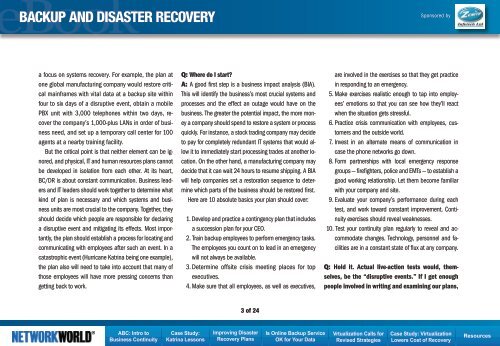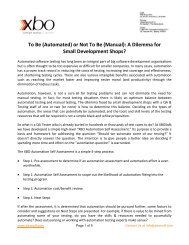BACkUP AnD DIsAstER RECoVERY - Bitpipe
BACkUP AnD DIsAstER RECoVERY - Bitpipe
BACkUP AnD DIsAstER RECoVERY - Bitpipe
Create successful ePaper yourself
Turn your PDF publications into a flip-book with our unique Google optimized e-Paper software.
BACKUP AND DISASTER RECOVERYSponsored bya focus on systems recovery. For example, the plan atone global manufacturing company would restore criticalmainframes with vital data at a backup site withinfour to six days of a disruptive event, obtain a mobilePBX unit with 3,000 telephones within two days, recoverthe company’s 1,000-plus LANs in order of businessneed, and set up a temporary call center for 100agents at a nearby training facility.But the critical point is that neither element can be ignored,and physical, IT and human resources plans cannotbe developed in isolation from each other. At its heart,BC/DR is about constant communication. Business leadersand IT leaders should work together to determine whatkind of plan is necessary and which systems and businessunits are most crucial to the company. Together, theyshould decide which people are responsible for declaringa disruptive event and mitigating its effects. Most importantly,the plan should establish a process for locating andcommunicating with employees after such an event. In acatastrophic event (Hurricane Katrina being one example),the plan also will need to take into account that many ofthose employees will have more pressing concerns thangetting back to work.Q: Where do I start?A: A good first step is a business impact analysis (BIA).This will identify the business’s most crucial systems andprocesses and the effect an outage would have on thebusiness. The greater the potential impact, the more moneya company should spend to restore a system or processquickly. For instance, a stock trading company may decideto pay for completely redundant IT systems that would allowit to immediately start processing trades at another location.On the other hand, a manufacturing company maydecide that it can wait 24 hours to resume shipping. A BIAwill help companies set a restoration sequence to determinewhich parts of the business should be restored first.Here are 10 absolute basics your plan should cover:1. Develop and practice a contingency plan that includesa succession plan for your CEO.2. Train backup employees to perform emergency tasks.The employees you count on to lead in an emergencywill not always be available.3. Determine offsite crisis meeting places for topexecutives.4. Make sure that all employees, as well as executives,are involved in the exercises so that they get practicein responding to an emergency.5. Make exercises realistic enough to tap into employees’emotions so that you can see how they’ll reactwhen the situation gets stressful.6. Practice crisis communication with employees, customersand the outside world.7. Invest in an alternate means of communication incase the phone networks go down.8. Form partnerships with local emergency responsegroups — firefighters, police and EMTs — to establish agood working relationship. Let them become familiarwith your company and site.9. Evaluate your company’s performance during eachtest, and work toward constant improvement. Continuityexercises should reveal weaknesses.10. Test your continuity plan regularly to reveal and accommodatechanges. Technology, personnel and facilitiesare in a constant state of flux at any company.Q: Hold it. Actual live-action tests would, themselves,be the “disruptive events.” If I get enoughpeople involved in writing and examining our plans, of 24ABC: Intro toBusiness ContinuityCase Study:Katrina LessonsImproving DisasterRecovery PlansIs Online Backup ServiceOK for Your DataVrtualization Calls forRevised StrategiesCase Study: VirtualizationLowers Cost of RecoveryResources













